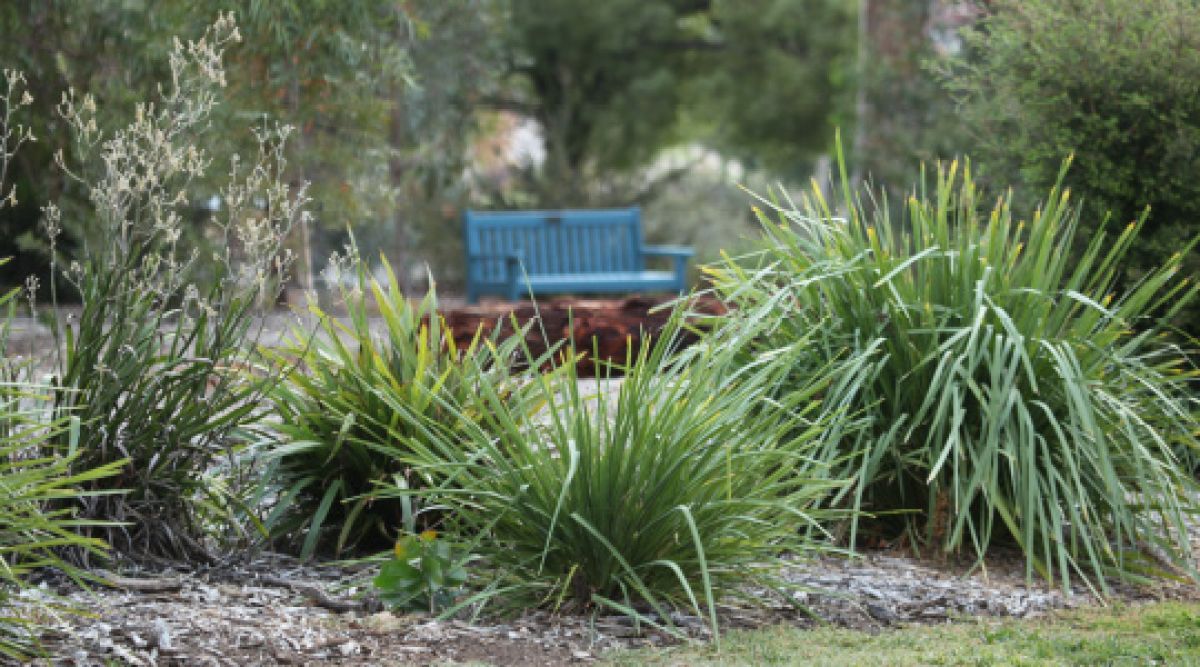Australian Native Flora Section

This pleasantly secluded area is entered via a lattice arch. The main area of this section features scattered trees in lawn areas, with native plantings around the perimeters. Many of the shrubs featured in these borders have been left unpruned, and have grown naturally. This gives an insight into ultimate growth forms if judicious pruning is not practiced.
The The Native Flora Section was the first garden to be completed at the Botanic Gardens. As funds were limited during the creation of the gardens, Tom Wood wrote to many gardens across Australia asking for donations of plants or seeds. However, the response was disappointing and Wood was unable to gather the variety of plants that he wanted. As luck would have it, a local nursery owner in Henty named Sensenderfer came to the rescue! Sensenderfer was passionate about Australian natives and had a huge variety of plants available.
Camellia Garden

This garden was established as a Bicentennial project by the Quota Club of Wagga Wagga, the Hume Region Branch of the Camellia Society, the Wagga Wagga City Council and various other sponsors.
The Camellia Garden was created to acknowledge the relationship between Wagga Wagga and its sister city Kunming in China. The pavilion and gates at the gardens were a gift to the city during the Bicentenary in 1988. Skilled artisans and craftsmen from Kunming travelled to Wagga Wagga, living and working at the gardens for four months while the garden was created and the pavilion was built. Everything for the gardens was brought from China, including the large rocks!
Some of the Camellia plants are from Kunming, but most of them came from a private collector in Melbourne who was unable to keep their collection and wanted the plants to go to a garden where they would be appreciated. There are over 300 different species of Camellia in this garden, making it one of the most diverse Camellia gardens in Australia.
Shakespearian Garden

This small garden was funded by the Shakespearian Society of Wagga Wagga. The Wagga Wagga Shakespeare Club is the oldest continuing Shakespeare group in the world. To acknowledge and celebrate this achievement, the group worked with Council to establish the Shakespeare Garden as part of Bicentennial celebrations.
The garden is designed on the stylish line characteristic of the Elizabethan period and the plants in the garden are featured in the Bard’s plays and sonnets.. The small formal beds are planted and trimmed to form what is known as a Knot Garden, which is a style typical of the time, and is enclosed as most Elizabethan gardens were.
Cactus and Succulent Garden

This area features drought resistant plants from Africa and America, which is another Bicentennial Project with the assistance from the Cactus and Succulent Society of Wagga Wagga.
All plants within the garden originate from areas with low rainfall and have adopted succulence as a method of withstanding drought.
Rainforest Gully

The gully is accessed by red gum steps and displays assorted ferns and rainforest trees. The whole area is kept moist and humid by an automatic spray system that operates throughout the day to create the conditions required to grow rainforest plants in a very hot and dry climate like Wagga Wagga.
Waterwise Garden

The Waterwise garden was developed to demonstrate and provide practical advice on landscaping and irrigation which can be used to reduce water usage. The garden displays are all hands-on and systems can be seen and touched. Both native and exotic plants are incorporated into this garden.
Rose Garden

The David Jones Memorial Rose Garden, is ablaze with colour when in full bloom. Wagga Wagga provides ideal growing conditions for roses.
Island and Bamboo Garden
These gardens overlook a pond and have been developed with the assistance of the Wagga Wagga Sunrise Rotary Club. The gazebo is surrounded by a spectacular bamboo garden and is very popular for weddings and formals.
Protea Garden
This garden displays a range of Proteas suitable for growing in Wagga Wagga
